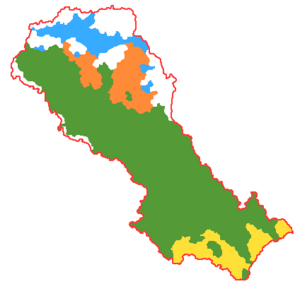Kroraine
Federal Democratic Republic of Kroraine Krorainentse Śamnäṣṣuva Miṃcuteya Cantre | |
|---|---|
Motto: Tañ nesem, arai kartseya Kroraina. "Us for you, O beautiful Kroraine" | |
Anthem: Guṇacaṃdrentse Yapoy "Land of Gunachandra" | |
 | |
| Capital and largest city | Korla |
| Official languages | Kroraini |
| Recognised regional languages | |
| Ethnic groups (2015) |
|
| Religion (1995) |
|
| Demonym(s) | Kroraini Shanshanese (chiefly historical) |
| Government | Federal parliamentary republic |
| Puñamitre Kaṣyāre | |
| Vrauske Kunlyumeṃ | |
| Kāḍike Tsyakune | |
| Etriṣe Katakarṇi | |
| Legislature | Saṃsade |
| Klyomñentse Kercci | |
| Ankāmnintse Kercci | |
| Formation | |
• Shanshan Kingdom first attested | 630 CE |
• Gunachandra unifies the Kroraini petty kingdoms | 770-790 |
• Idiqut Dynasty takes the throne | 1006 |
• Protectorate of the Tao Empire | 1132 |
• Independence Declared | 5 May 1936 |
| 1936-1954 | |
• Treaty of Turpan | 23 November 1954 |
| Area | |
• Total | 275,966.01 km2 (106,551.07 sq mi) |
• Water (%) | 2.8% |
| Population | |
• Estimate | 18,576,600 (2019) |
• 2015 census | 18,248,281 |
• Density | 66.12/km2 (171.3/sq mi) |
| GDP (PPP) | 2012 estimate |
• Total | $140.530 billion |
• Per capita | $7,701 |
| GDP (nominal) | 2012 estimate |
• Total | $51.861 billion |
• Per capita | $2,842 |
| Gini | 32.8 medium |
| HDI | medium |
| Currency | Ṣotre (₹) (KRS) |
| Time zone | UTC+1:00 (KST) |
| Date format | yyyy-mm-dd |
| Driving side | right |
| Calling code | +27 |
| Internet TLD | .kro |
Kroraine, officially the Federal Democratic Republic of Kroraine (Kroraini: Krorainentse Śamnäṣṣuva Miṃcuteya Cantre, pronounced [kroˈrəɪ̯nent͡se ɕəmˈnɨʃuʋə minˈt͡ɕutejə ˈt͡ɕəntre]), is a sovereign state in central Coius. Kroraine is a landlocked country, dominated by the Tarya river valley which runs from north to south throughout the length of the country. It is bordered by Yi to the south, Xiaodong to the west, Zorasan to the north, and ??? to the east. The capital and most populous city is Korla, which lies in the northern half of the country.
The earliest known inhabitants of the area of modern Kroraine were a caucasoid people, often with red or blonde hair, dating to at least the 2nd millennium BCE. Various nomadic peoples, such as the Yuezhi and Wusun of Xiaodongese sources, were part of the migration of Hyndo-Euclean speakers who settled in Central Coius during that period. Although geographically isolated by its mountainous boundaries and highly variegated and often inhospitable terrain, which has helped to preserve its unique culture, Kroraine has been at the crossroads of several great civilisations as part of the Silk Road and other commercial and cultural routes. It has long been dominated by foreign powers, in particular the Xiaodongese, and attained sovereignty as a nation state only after securing its independence from the Auspicious Republic in 1954.
Since independence, Kroraine has officially been a federal parliamentary republic, although it has endured some internal conflicts and political strife.
Ethnic Krorainis make up a majority of the country's nearly 19 million people, followed by notable minorities of Yi, Gojalis and Xiaodongese. The Saka would be considered the second largest ethnic group ahead of the Yi, but they are generally considered to be Krorainis as well. The Kroraini language, also known as Shanshanese, is the primary official language of Kroraine, although Xiaodongese remains widely spoken as an inter-ethnic language — a legacy of centuries of Xiaodongese rule over Kroraine. The majority of the population practice a local syncretic form of Satyism, although there are significant numbers of pagans and irreligious people. The culture of Kroraine bears similarity to those of its neighbouring nations, in addition to its autochthonic heritage.


